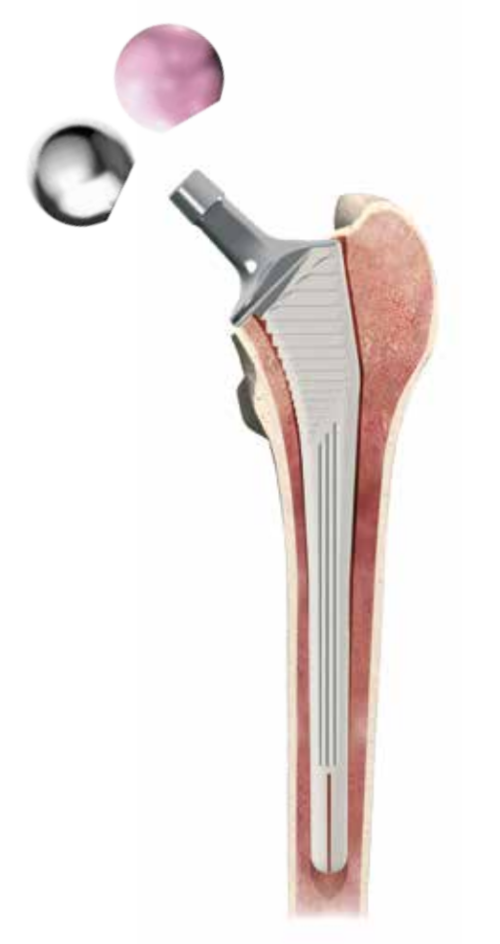CASE 22: Complex primary hip replacement to correct extreme leg length inequality
The Story
“Liam is a 57-year old gentleman who presented with a complex orthopaedic history. As a young teenager, he suffered a slipped upper femoral epiphysis (SUFE) which required operative intervention. He underwent pinning and an osteotomy to try and repair his SUFE. This enabled him to return to cycling and walking throughout his adult life.
When he presented to me, Liam had been experiencing progressive shortening of his right leg which left him with a leg length discrepancy and a very stiff hip joint. This got to a point where it was reducing his mobility, so we decided to intervene.”
The Investigation
On clinical examination, Liam was using a large right shoe raise to correct his leg length discrepancy. He had a reduced range of movement in the right hip and all movements caused significant pain. There were no sensory or vascular abnormalities.
The Evidence
Anteroposterior plain radiograph demonstrating a severe deformity of the right hip, with pins in the right femur from previous surgery to repair his slipped upper femoral epiphysis.
Anteroposterior long leg radiograph which is used to determine the source of the leg length discrepancy and plan the surgery. Newer imaging methods such as EOS are now available.
The Diagnosis
Liam was diagnosed with a severe right femoral deformity leading to a stiff right hip joint and a leg length discrepancy. The femoral anatomy is complex and is difficult to predict which femoral stem will provide the best fit, adequate femoral version and reconstruction of vertical and horizontal femoral offsets.
The Plan
My first choice was the Corail standard stem and my backup was the Corail long stem. If broaching with the standard stem did not provide satisfactory rotational stability, I planned to use the long stem for additional fixation.
Long stem corail used in revision for Paprosky Type 2 & 3A defects, or primary for osteoporotic bone, or very large femurs.
The Operation
We accessed the hip through a posterior approach, being careful to protect the sciatic nerve at all times. We were able to remove one of the femoral screws from his previous surgery, with the other being buried within the femur.
The joint was dislocated. We prepared the acetabulum using sequential reamers up to 53mm to accept a 54mm cup. This was inserted using a single screw to achieve an excellent hold and a ceramic liner was inserted.
Then the femur was prepared to allow for a standard length, siize 14 Corail stem. This did not achieve satisfactory rotational stability so a long stem Corail was trialed. This had a good fit and the joint was stable. A ceramic head was used with the best possible reconstruction of vertical and horizontal femoral offsets: the hip was stiffer and tighter than a standard primary hip.
The hip was then reduced the surgical site was washed and closed.
The Outcome
Anteroposterior plain radiograph taken immediately after the procedure demonstrating satisfactory positioning of the long stem Corail implant. Intra-operatively, the hip was stiffer and tighter than a standard primary. the patient was happy with the leg length.
Anteroposterior plain radiographs taken one-year after Liam’s procedure. They show that the implant hasn't moved since the post-operative image was taken.
EOS taken at 18-months after Liam’s operation. This demonstrates a well fixed implant in an optimal position with no residual leg length discrepancy.
Liam made a very good recovery. He is now able to mobilise without pain and he is very happy with the overall result.
The Verdict
“The use of a long non-modular femoral stem allows the surgeon to obtain a more secure fit, when compared to standard length implants, in cases of complex deformity and retains the familiar neck geometry and conserves femoral bone by avoiding more distal fixation. The use of long leg radiographs can help in determining the source of a leg length discrepancy but now we opt to use EOS scanning. This method uses low dose x-ray radiation to take orthogonal images of patients in functional positions (standing and sitting). Not only can this help to understand a leg length discrepancy, but it can account for pelvic tilt.
Cases like these stand to benefit from 3D CT-based planning to better predict the suitability of standard stems and the need for more stems with enhanced fixation. CT planning can predict stem size, stem length and possibilities for leg length restoration. It is limited by the uncertainty of the soft tissues, so that in this case we lengthened the right leg as much as the soft tissues would allow following 360 degree capsulotomy and gluteus Maximus tendonotomy and preservation of the abductor muscle origin and psoas tendon insertion.
In previous years, stem selection has included modular-neck stems to help with intra-operative adjustment, but these are no longer favoured so a non-modular neck stem is preferred.”
-
Cases with complex proximal femoral anatomy justify CT based planning:
-
Evidence for this treatment
The use of Corail long stems in complex hip surgery is well documented:
-
Please see Case 24 to learn the limitations of using modular-neck femoral stems










